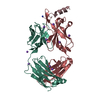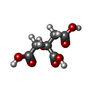+Search query
-Structure paper
| Title | Structural basis and mode of action for two broadly neutralizing antibodies against SARS-CoV-2 emerging variants of concern. |
|---|---|
| Journal, issue, pages | Cell Rep, Vol. 38, Issue 2, Page 110210, Year 2022 |
| Publish date | Jan 11, 2022 |
 Authors Authors | Wenwei Li / Yaozong Chen / Jérémie Prévost / Irfan Ullah / Maolin Lu / Shang Yu Gong / Alexandra Tauzin / Romain Gasser / Dani Vézina / Sai Priya Anand / Guillaume Goyette / Debashree Chaterjee / Shilei Ding / William D Tolbert / Michael W Grunst / Yuxia Bo / Shijian Zhang / Jonathan Richard / Fei Zhou / Rick K Huang / Lothar Esser / Allison Zeher / Marceline Côté / Priti Kumar / Joseph Sodroski / Di Xia / Pradeep D Uchil / Marzena Pazgier / Andrés Finzi / Walther Mothes /   |
| PubMed Abstract | Emerging variants of concern for the severe acute respiratory syndrome coronavirus 2 (SARS-CoV-2) can transmit more efficiently and partially evade protective immune responses, thus necessitating ...Emerging variants of concern for the severe acute respiratory syndrome coronavirus 2 (SARS-CoV-2) can transmit more efficiently and partially evade protective immune responses, thus necessitating continued refinement of antibody therapies and immunogen design. Here, we elucidate the structural basis and mode of action for two potent SARS-CoV-2 spike (S)-neutralizing monoclonal antibodies, CV3-1 and CV3-25, which remain effective against emerging variants of concern in vitro and in vivo. CV3-1 binds to the (485-GFN-487) loop within the receptor-binding domain (RBD) in the "RBD-up" position and triggers potent shedding of the S1 subunit. In contrast, CV3-25 inhibits membrane fusion by binding to an epitope in the stem helix region of the S2 subunit that is highly conserved among β-coronaviruses. Thus, vaccine immunogen designs that incorporate the conserved regions in the RBD and stem helix region are candidates to elicit pan-coronavirus protective immune responses. |
 External links External links |  Cell Rep / Cell Rep /  PubMed:34971573 / PubMed:34971573 /  PubMed Central PubMed Central |
| Methods | EM (single particle) / EM (subtomogram averaging) / X-ray diffraction |
| Resolution | 2.15 - 12.0 Å |
| Structure data |  EMDB-25200: CryoEM structure of SARS-CoV-2 HexaPro spike in complex with S2-binding CV3-25  EMDB-25564:  EMDB-25565:  EMDB-25566:  PDB-7nab: |
| Chemicals |  ChemComp-NA:  ChemComp-CIT:  ChemComp-HOH: |
| Source |
|
 Keywords Keywords | VIRAL PROTEIN/IMMUNE SYSTEM / human neutralizing mAb / MPER-targeting / SARS-CoV-2 / spike / VIRAL PROTEIN-IMMUNE SYSTEM complex |
 Movie
Movie Controller
Controller Structure viewers
Structure viewers About Yorodumi Papers
About Yorodumi Papers



 homo sapiens (human)
homo sapiens (human)
